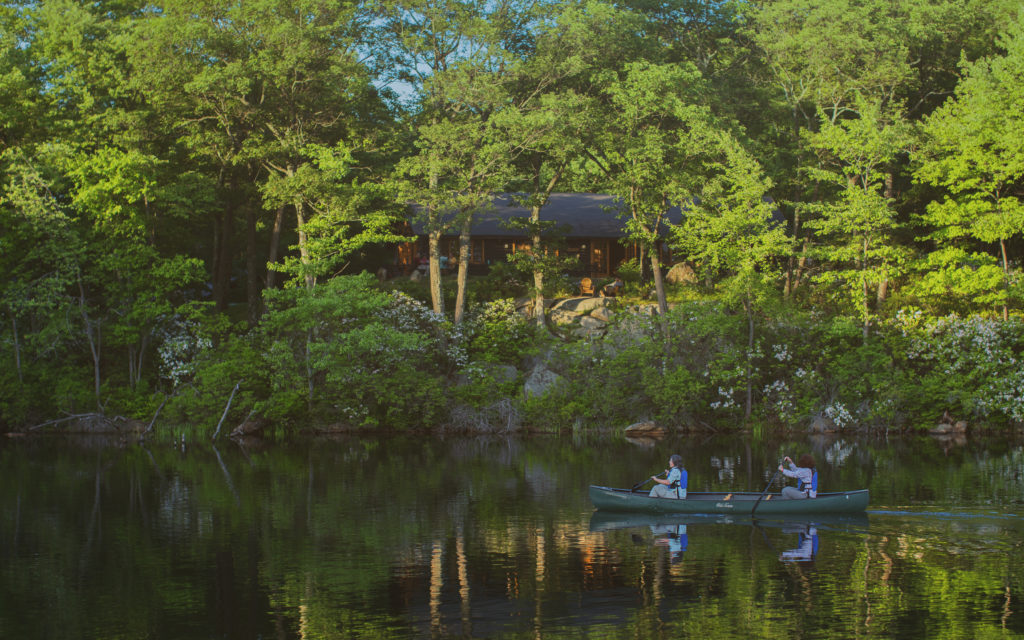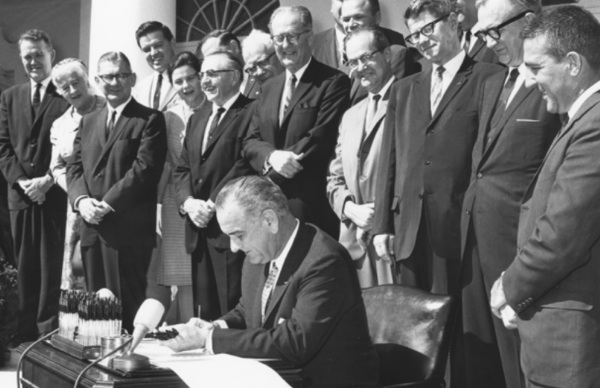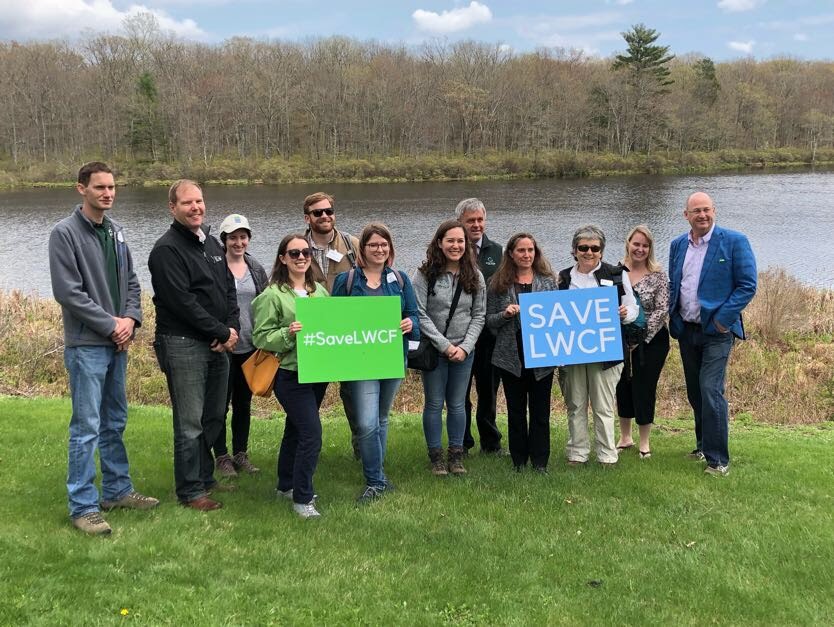

Breakneck Pond, located at AMC’s Corman Harriman Outdoor Center in New York, is one of more than 40,000 outdoor recreation projects supported by the Land and Water Conservation Fund—which was permanently funded through the Great American Outdoors Act.
The Great American Outdoors Act, a bipartisan piece of legislation signed by President Trump on Tuesday, August 4, will provide as much as $1.9 billion annually to address the massive backlog of maintenance projects on federal public lands—including national parks, forests, and refuges—and will permanently fund a federal program that has supported outdoor conservation in nearly every county in the country since Lyndon Johnson’s presidency.
Throughout its 55-year history, the Land and Water Conservation Fund (LWCF) has used royalties paid by oil and gas companies drilling offshore to partially fund more than 40,000 outdoor recreation projects, from land acquisition in national parks to helping create local parks and playgrounds. These LWCF grants have totaled $18.9 billion, according to the Department of the Interior, which manages the program. But the fund, which is authorized at $900 million annually, has rarely seen the financial support it was originally promised.
Historically, only about half of the LWCF’s money has been used for conservation. Instead, large portions of the money were diverted to other unrelated spending needs during Congress’ annual appropriations process, says Amy Lindholm, AMC conservation staff and coordinator of the LWCF Coalition, a nationwide alliance of more than a thousand individual organizations that form the fund’s main advocacy group.
“The $900 million has flowed in every year but it must be appropriated by Congress before it can be spent,” Lindholm explains. “Congress has chosen to appropriate half or less, on average, and the rest of the money has simply disappeared into the general Treasury.” That lost money has instead been spent as regular tax revenue—on the military, schools, or other items in the federal budget. Until today.
With the passage of the Great American Outdoors Act, which cleared the Senate on June 17 and the House of Representatives on July 22, the LWCF will be permanently funded at its intended yearly allocation of $900 million. John Judge, AMC’s president and CEO, celebrated the historic passage of the GAOA—and the club’s role in the LWCF through the years.
“AMC is a leader in the national LWCF Coalition, bringing together diverse voices from around the country to advocate for conservation funding through LWCF,” says AMC president and CEO John Judge. “Without the engagement of more than 1,000 nonprofit organizations, businesses, local elected officials, recreationists and other stakeholders, as well as hundreds of thousands of AMC members and outdoor enthusiasts over the past decade, the success of permanently reauthorizing and fully funding the LWCF may not have come to be.”


President Johnson signing LWCF into law in 1964.
A unique approach, with wide-ranging benefits
On February 8, 1965, in a special address to Congress on conservation, President Johnson spoke of the importance of preserving the outdoors for future generations to come.
“For centuries Americans have drawn strength and inspiration from the beauty of our country,” he said. “It would be a neglectful generation indeed… which failed to preserve and extend such a heritage to its descendants.”
Just a few months prior, Johnson had established the LWCF as a unique government spending program. Instead of using tax revenues, the program would apply royalties paid by drilling companies toward supporting conservation efforts around the country.
“The idea of the LWCF is that you would offset the drawdown of those non-renewable natural resources by investing in capital natural resources of land and water and recreation infrastructure with some of those profits,” Lindholm says.
Included in the thousands of LWCF-funded conservation projects is the federal government’s purchase of “inholdings”—privately owned land within the existing boundaries of a protected area—which can be found in many national parks or similar preserves. If the government determines that buying that land would help the overall mission of the park or protect the visitor experience, it may use funds from the LWCF to do so.
To this end, the LWCF has contributed to the preservation and conservation of portions of the Appalachian National Scenic Trail, which stretches more than 2,000 miles along the east coast. But the fund has also been essential to the local city and state parks that millions of Americans use every day.
Each year, states are apportioned money from the LWCF based on their population. Municipalities and government agencies can apply to their state to use some of that funding for conservation projects, as long as they match any grants they are given. This helps communities like Waterville, Maine, which in 2015 received a $300,000 LWCF grant to repurpose a demolished industrial park on the Kennebec River. Along with more than $1 million in matching funds, the city built RiverWalk at Head of Falls, which contains a landscaped boardwalk, gazebo, children’s play area, and small amphitheater along the river.
“It completely transformed that stretch of Waterville,” says Doug Beck, an outdoor recreation supervisor for Maine’s Bureau of Parks and Lands, adding that nearly 900 other projects in Maine have received LWCF funding through the years.
South of Waterville, in Portland, Deering Oaks Park’s small pond, playground, baseball field, and tennis courts exist because of the LWCF. In Acton, Maine, near the New Hampshire border, Goat Hill Trail sits on nearly 250 acres of land that would have otherwise become a residential development were it not for an LWCF grant in 2017.
“It would be challenging to find a community in Southern Maine that has not received a Land and Water Conservation grant,” Beck says.
In western Massachusetts, the Norwottuck Rail Trail has similarly benefited from LWCF money, says Kristen Sykes, AMC’s director of southern New England conservation projects and partnerships. The trail’s 11 miles stretch through Northampton, Hadley, Amherst, and Belchertown and offer a paved path for walkers, runners, and bikers from nearby towns and college campuses.
A multifaceted fund
Further money from the LWCF goes to an assortment of conservation programs, including the Forest Legacy Program, which allows states to receive grants to protect at-risk forests.
“It allows sustainable forestry and timber production to continue while opening up public recreational access and keeping forests as forests,” Lindholm says. The program has helped protect 2.6 million acres of land in 53 states and territories.
The Outdoor Recreation Legacy Program (ORLP), another national initiative that relies on LWCF grants, supports creating and maintaining outdoor spaces in cities greater than 50,000 people. This program addresses shortcomings of funding for urban recreation areas by placing a special focus on helping communities that are economically disadvantaged.
Since its establishment in 2014, ORLP grants have supported the development of Fort Dupont Park in Washington, D.C., Jesse Allen Park in Newark, N.J., and Colt Park in Hartford, Conn., among others. One of the most recent grants was awarded to the City of Providence, R.I., for further work on removing industrial infrastructure and creating multi-use recreational adventure park surrounded by the Woonasquatucket River Greenway.
Community parks have seen huge spikes in use during the COVID-19 pandemic as stay-at-home orders have led families to seek natural outlets and ensure children can get adequate exercise. Presque Isle State Park in Erie, Penn.—which has been supported by the LWCF—“saw visitor numbers jump 165 percent year-over-year during the third week of March 2020,” according to Bloomberg’s Patrick Sisson.
“We have seen very starkly in this pandemic how much those local parks, trails, and recreation areas are desperately needed,” Lindholm says.


In 2018, AMC joined thousands of environmental allies in pushing for the reauthorization of the LWCF, which funds conservation and recreation projects throughout the nation. Congress reauthorized LWCF in 2019.
A difficult path
The LWCF has historically received bipartisan support. In 1990, when its initial 25-year authorization expired, it was passed for another 25 with little controversy.
“Land conservation is in a slightly different category than many other environmental issues,” Lindholm says. “It’s something that has historically been popular across the political spectrum. You have conservative-leaning hunters and anglers who are just as passionate conservationists as the greenest, crunchiest Greenpeace members.”
For decades, AMC fought for the highest possible annual Congressional appropriations for projects that would protect forests and recreational opportunities of regional and national significance, Lindholm adds.
But over the past decade, the rise of anti-federal government, budget-hawkish factions like the Tea Party threatened the fund’s future, Lindholm says. “You had this far-right flank that was using a lot of misinformation, calling it a ‘federal land grab,’ really making it about the federal government owning more land when that’s really not what the program is about at all,” she says. “It became politicized and we ended up in a fight to save the program itself.”
The fund went through several short-term extensions before AMC and the LWCF Coalition campaigned successfully for permanent reauthorization, winning with widespread support in 2019. In addition to field organizing led by AMC for years, AMC Chapters across the entire region helped raise awareness and advocacy for permanent reauthorization—and the ideal of permanent funding—by leading trips to places that have been protected by LWCF. During these trips, leaders would provide an up close look at how the program has benefitted the Northeast and the people who live and recreate there.
Although the 2019 reauthorization did not permanently fund the LWCF, it was a springboard for this year’s push to ultimate success on permanent funding that concluded August 4.
Republican senators and bill co-sponsors Cory Gardner of Colorado and Steve Daines of Montana were key in shepherding the act through the Senate, where it drew support from all but one senator in AMC’s region. Congressmen Jared Golden (D–ME) and Brian Fitzpatrick (R–PA), original co-sponsors of the House bill, were boosters of the bill from early on, while Congressman James McGovern (D–MA)—who has kept the LWCF front and center for nearly a quarter-century—helped ensure the act would pass smoothly as chair of the House Rules Committee. AMC’s Judge praises the bipartisanship that buttressed the sustained funding of precious lands and waters.
“This kind of long-term, grassroots engagement across the political spectrum shows that conservation is both a critical issue for the future of our country and our planet and a winning issue that unites Americans around the value of the outdoors,” he says.
Next steps
After decades of Congress redirecting LWCF funds, the program currently has a massive backlog of projects awaiting funding, though the exact cost of lost projects is unclear.
“Every year there are projects that go unfunded. Some of those projects come back the next year and try again, and some don’t,” Lindholm says. “Deals fall apart, landowners may not be able to wait any longer to sell. So, it’s impossible to know comprehensively what has happened to them.”
And though the fund’s annual output will now be twice its historical average, it could go even higher in the future. The $900 million mark originally set to be the annual funding level for LWCF is based on real estate prices that are half-a-century out of date.
But Lindholm says the LWCF Coalition has been careful to focus on the task at hand, for now. In the wake of a conservation victory like the passage of the Great American Outdoors Act, Lindholm says that it will be important to let the public know what goes into building and protecting the spaces they use and love before seeking an expansion of the LWCF.
“I think we’ll focus first on getting that money on the ground and making sure people know that when places are protected it’s because of the Great American Outdoors Act and because of LWCF,” she says. “Then we can see what more might be needed next, to fully meet the climate and nature crisis we face.”
Donate Now: Your gift today will further AMC’s mission to foster the protection, enjoyment, and understanding of the outdoors.